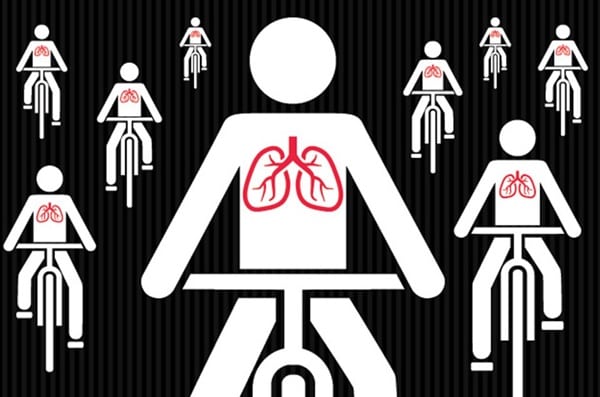What Happens To Your Lungs When You Ride
Your airbags help get the oxygen you need to where you need it, when you need it most. Here’s how they work.
Your airbags help get the oxygen you need to where you need it, when you need it most. Here’s how they work. – By Selene Yeager

There’s a reason fitness is measured in terms of VO2 max, the highest rate of oxygen your body can consume during maximal or exhaustive exercise: To perform physical activity like riding a bike, especially if you want to go far and/or fast, your body needs to consume a lot of oxygen. The more oxygen you can circulate to burn fat and keep your aerobic energy production churning, the longer and faster you can ride without fatiguing.
Read: How Changing Your Breathing Can Improve Your Performance
“VO2 is a function of how efficiently you breathe,” says Paul W. Davenport, PhD, distinguished professor in the Department of Physiological Sciences at the University of Florida in the United States, who specialises in the study of the respiratory response to exercise. Which, of course, is where the lungs come in. Here’s how they work.
Your lungs inflate
Your lungs are like fleshy hydration-pack bladders that inflate when you breathe into them. Their primary job is drawing in oxygen-rich air and expelling carbon-dioxide waste generated by your cells. That gas-exchange happens in the alveoli – microscopic, grape-like sacs that line your lungs.
As you start to pedal, you pull air into your lungs and alveoli and they expand like a tyre being pumped. Oxygen-depleted blood passes into the lungs, dumping off its carbon dioxide in exchange for fresh oxygen, and then goes back into the heart to be pumped into your muscles.
You use more lung space
As you ride, especially when you go harder – like hammering a paceline or climbing a hill – your muscles’ energy-producing mitochondria need more oxygen, so you have to extract more from the lungs. Your heart rate goes up and your stroke volume increases so there’s more blood pouring through the lungs. You not only breathe faster, but also breathe more deeply to expand and enlarge your alveoli, so you have greater oxygen exchange with every breath.
Your abs spring into action
Drawing deeper breaths expands and enlarges your alveoli, but there’s a price to pay, says Davenport. “It’s more work and uses more of your body’s energy,” comparable to pumping up a tyre: It’s fairly easy to inflate your bike tyres to the lower end of their recommended psi range, but as you approach the upper limits, it takes more force.
To assist, your body recruits your expiratory muscles – primarily your abdominals – to blow out more air faster, so you can get more in faster.
“Normally, you sit at a baseline midpoint, where you still have some air in your lungs – your expiratory reserve – when you exhale,” says Davenport. “When you’re exercising, you use part of that expiratory reserve and blow out more than you would at rest.”
Your diaphragm pulls in more air
After you actively exhale using part of your expiratory reserves, your lungs are small and deflated like shrunken balloons, leaving you more space to fill with the oxygen-rich air your working muscles demand. That task is performed by your inspiratory muscles, which are your intercostals (the muscles between your ribs) and your diaphragm, a thin parachute-shaped muscle at the base of your lungs.
You inhale more gunk
As your oxygen demands increase, you need to switch the input from the two small holes in your face that can only expand so far to the one that can gape wide-open for maximum oxygen intake.
Problem is, as you switch from nose- to mouth-breathing, you lose your filtering system.
“Your nose filters, warms and humidifies the air,” says Davenport. Lacking the same fine-hair filtration system as your nose, your mouth lets in considerably more microscopic material that would normally be filtered out. That’s why some off-road riders will pull a Buff or bandana over their mouths during particularly dusty parts of the ride.
You push out more gunk
You know that “racer cough” you sometimes develop after hard efforts? Barring exercise-induced asthma, it’s likely just your lungs clearing themselves.
“When you’re blowing out air faster, you can blow some things out of your airway that would typically come out more slowly at rest,” says Davenport. When gunk reaches your trachea, it triggers a cough to expel it. Naturally, if you’ve been sucking in more debris than usual from taking deep breaths through your mouth, you’ll have more debris (and built-up mucous that surrounds it) to expel.
Your respiratory muscles get stronger
All that hard work makes your respiratory muscles stronger than they would be if you didn’t ride or exercise. In one study published in Respiratory Physiology and Neurobiology, researchers found that 12 weeks of high-intensity interval training could make small but significant improvements in the abdominal expiratory muscles as well as the diaphragm.
For more measureable improvements, you can target these muscles with specific training, says Davenport. In a review of respiratory training studies published in Sports Medicine, researchers from Switzerland found that respiratory muscle training improved endurance performance in tests to exhaustion, with those who were less fit to begin with and those who participate in ultra-endurance events.
READ MORE ON: health strength training programmes workouts

